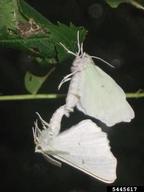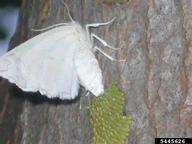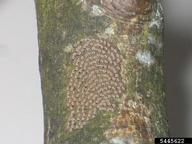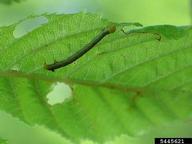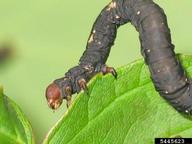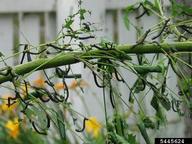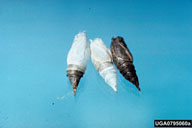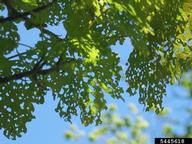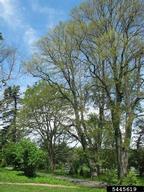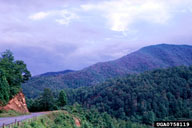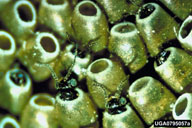Elm spanworm
Ennomos subsignarius (Hübner) (Lepidoptera: Geometridae)
Orientation to pest
Elm spanworm, Ennomos subsignarius (Hübner), is a native geometrid moth whose polyphagous larvae feed on many species of hardwood trees, especially hickory (Carya), oak (Quercus), and ash (Fraxinus). It is most important as a forest pest in the Appalachian Mountains, from Pennsylvania south, but an urban forest outbreak has also occurred in St. John's, Newfoundland and Labrador. This univoltine species overwinters as eggs, which are laid in clusters on the bole and on the underside of branches. Eggs hatch in early spring and young larvae feed on the lower surfaces of leaves, producing "shot-hole" damage. Older larvae consume the whole leaf apart from the major veins. After developing through five instars, larvae pupate in loose silk cocoons formed on the partly eaten foliage and in bark crevices. Outbreaks of this species occur at irregular intervals that defoliate trees over wide areas.
Hosts commonly attacked
This species feeds on elm (Ulmus), hickory (Carya), oak (Quercus), maple (Acer), beech (Fagus), and ash (Fraxinus).
Distribution
This geometrid is found in hardwood forests from Newfoundland and Labrador to Saskatchewan in Canada and throughout the eastern United States, west to Michigan, Colorado, and Texas.
Images of elm spanworm
| Figure 1. Adults of elm spanworm, Ennomos subsignarius, mating (left) or laying eggs (right) | Figure 2. Egg mass of elm spanworm | |
| Figure 3. Early (left) and late (right) instar larvae of elm spanworm | Figure 4. Masses of elm spanworm larvae feeding on host plant during an outbreak | Figure 5. Pupae of elm spanworm | |
| Figure 6. Shot hole or tattered damage from feeding of elm spanworms | Figure 7. Trees defoliated by elm spanworm | Figure 8. Defoliation of a forest stand by elm spanworm | Figure 9. Adults of the egg parasitoid Telenomus droozi emerging from eggs of elm spanworm |
Important biological control agents related to this pest species
Some of the more important biological control agents affecting this species are the egg parasitoid Telenomus droozi Muesebeck and the predatory carabid Calosoma scrutator (F.), which eats larvae.
Web links for information on elm spanworm
Articles
- Anderson, J. F. and K. K. and Harry. 1976. Parasitoids and diseases of the elm spanworm. Journal of the New York Entomological Society. 84: 169-177.
- Drooz, A. T. 1980. A review of the biology of the elm spanworm (Lepidoptera: Geometridae). Great Lakes Entomologist 13: 49-53.
- Fry, H. R. C., D. T. Quiring, K. L. Ryall, and P. L. Dixon. 2008. Relationships between elm spanworm, Ennomos subsignaria, juvenile density and defoliation on mature sycamore maple in an urban environment. Forest Ecology and Management 255: 2726-2732.
- Fry, H. R. C., K. L. Ryall, P. L. Dixon, and D. T. Quiring. 2008. Suppression of Ennomos subsignaria (Lepidoptera: Geometridae) on Acer pseudoplatanus (Aceraceae) in an urban forest with bole-implanted acephate. Journal of Economic Entomology 101: 822-828.
